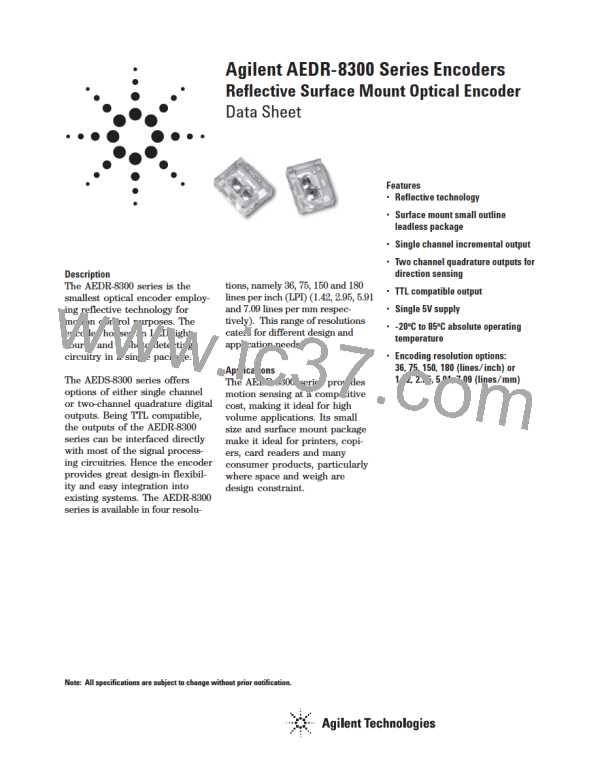Theory of Operation
IC, whereas no light is reflected
by the non-reflective area (bar).
An alternating light and dark
patterns corresponding to the
window and bar fall on the
Phase (φ): The number of electri-
cal degrees between the center of
high state of Channel A and the
center of high state of Channel B.
Nominally 90oe.
The AEDR-8300 series combines
an emitter and a detector in a
single surface mount leadless
package. When used with a
codewheel or linear codestrip,
the encoder translates rotary or
photodiodes as the codewheel
rotates. The moving light pattern
Phase Error (∆φ): The deviation
of phase, in electrical degree,
from its ideal value of 90oe.
linear motion into digital outputs. is exploited by the detector
As seen in the block diagram, the
AEDR-8300 consists of three
major components: a light emit-
ting diode (LED) light source, a
detector IC consisting photo-
diodes and lens to focus light
beam from the emitter as well as
light falling on the detector.
circuitry to produce digital
outputs representing the rotation
of the codewheel. When the
codewheel is coupled to a motor,
the encoder outputs is then a
direct representation of the
motor rotation. The same con-
cept applies to the use of a
Pulse Width (P): The duration of
high state of the output, in
electrical degree, within one
cycle. Nominally 180oe or half a
cycle.
codestrip to detect linear motion. Pulse Width Error (∆P): The
The operation of the encoder is
based on the principle of optics
where the detector photodiodes
sense the absence and presence
of light. In this case, the rotary/
linear motion of an object being
monitored is converted to
equivalent light pattern via the
use of codewheel/codestrip. As
shown in the above diagram, the
reflective area (window) of the
codewheel (or codestrip) reflects
light back to the photodetector
deviation of pulse width, in
electrical degree, from its ideal
value of 180oe.
Definitions
State Width (S): The number of
electrical degrees between a
transition in Channel A and the
Count (N): The number of
window and bar pair per revolu-
neighboring transition in Chan-
tion (CPR) of codewheel. For
nel B. There are 4 states per
linear codestrip, defined as the
number of window and bar pair
per unit length (lines per inch
[LPI] or lines per mm [LPmm]).
cycle, each nominally 90oe.
State Width Error (∆S): The
deviation of state width, in
electrical degree, from its ideal
value of 90oe.
One Cycle (C): 360 electrical
degrees (oe). Equivalent to one
window and bar pair.
One Shaft Rotation: 360 me-
chanical degrees. Also equivalent
to N counts (codewheel only).
V
LED
R
CODEWHEEL
OR
CODESTRIP
GND
Line Density: The number of
window and bar pair per unit
length, expressed in either lines
per inch (LPI) or lines per mm
(LPmm).
V
CC
CH A
CH B
SIGNAL
PROCESSING
CIRCUITRY
Optical radius (Rop): The
distance between the codewheel
center and the centerline be-
tween the two domes of the
encoder.
GND
Figure 1. Block Diagram of AEDR-8300.
2

 AGILENT [ AGILENT TECHNOLOGIES, LTD. ]
AGILENT [ AGILENT TECHNOLOGIES, LTD. ]